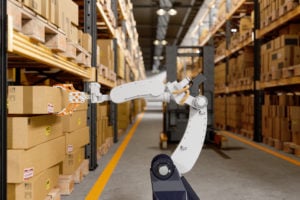2022: The Year of Automation

This article was originally published on SHD Logistics
In early 2022, global supply chains faced a wide range of challenges – labour shortages, fulfilment issues, and heightened end-customer expectations, among others. As supply chain technologies evolve, there is a new urgency for warehouse operations leaders to adopt more advanced automation tools.
In addition to overcoming these challenges, emerging advances in automation present opportunities for achieving more accuracy, greater efficiency, and better working environments for warehouse personnel.
But supply chain decision-makers must navigate this increasingly complex field, identifying the automation investments that will drive the best business results. This article considers the different types of warehouse automation emerging in 2022 and beyond, especially in the field of robotics.
Since early 2020, global supply chains have been forced to evolve into more intelligent and efficient operations. Automation, once in the playground of early adopters, has shifted into mainstream warehouse environments.
The growing interest in automation is driven in part by macro-industry trends: the rapidly growing sophistication of technology, key pain points in global supply chains like labour constraints, demand for faster fulfilment, and the growing need for real-time accuracy and efficiency in warehouse settings.
Gartner finds that 96% of supply chain organisations have used or plan to use cyberphysical automation of this kind in warehousing and manufacturing operations.
Aligning automation with traditional warehouse systems
Traditional warehouse automation systems already are widely used to improve efficiency and to reduce the need for manual labour. Examples include sortation systems that identify items on a conveyor system and divert products or packages to specific destinations. These systems are frequently combined with other common and emerging automated systems.
Pick-to-light systems featuring alphanumeric displays and buttons at storage locations to guide employees in light aided manual picking, putting, and sorting of packages or products. These systems may also include automated voice prompts to aid workers.
Goods-to-person systems that automatically transport goods directly to an operator as needed, thus eliminating travel time. These systems are commonly used in e-commerce fulfilment and in high-volume, single-piece picking environments with tight labour conditions.
Robot systems that are used for transporting goods – often via automated lift trucks and heavy load carriers – or to assist in picking, packing, sorting, and storing goods, along with other use cases. Gartner predicted demand for robotics goods-to-person systems will quadruple by 2023.
Automation use cases for modern supply chain organisations
Supply chain leaders that build their knowledge of automated systems are best positioned to identify winning use cases within their own operations. But applying these solutions requires an in-depth analysis of their existing processes and a disciplined approach to technology adoption. Four strategic goals in particular are growing popular among supply chain organisations today.
1. Overcoming lost productivity from labour shortages
Reductions in labour availability are driving more supply chain leaders to investigate cyber-physical automation as an alternative. Notably, today’s warehouse robots are optimised to work alongside human workers.
Although automation may supplement human labour, employees will require new skill sets to work successfully alongside robotics or automation assets. Technical skills will become critical as robots, smart machines, and artificial intelligence (AI) become more prevalent.
2. Increasing warehouse accuracy and efficiency
Depending on the tool, modern automation is designed to minimise errors, accelerate key processes, improve decision-making, and increase safety in the movement and distribution of products. Additionally, intelligent warehouse design means automation can be integrated with centralised digital systems, improving tracking, operations analysis, and optimisation in some cases.
Automation also stands to boost the efficiency and work experience of human laborers. Cobots (collaborative robots) that assist workers in picking processes can increase productivity and relieve humans from difficult and repetitive manual tasks. Untethered, 5G-enabled robots can also provide workers with greater mobility and flexibility in how they utilise cobots throughout the warehouse.
3. Accelerating fulfilment
Operational efficiencies driven by warehouse automation can contribute to a more omnichannel fulfilment model. Mobile automation like robots can optimise fulfilment processes as diverse customer orders are processed in ways that humans cannot – optimising their travel throughout the warehouse based on order queue and fulfilment requirements, for example. When multiple robots work together successfully as part of an intelligent system, supply chain leaders can realise dramatic improvements in fulfilment results.
4. Improving the end-customer experience
When orchestrated successfully, integrated automation can contribute to a better end-customer experience. Specifically, it can accelerate fulfilment and provide greater visibility into the status of customer orders. Automation can also reduce the rate of errors and damages throughout picking, packing, and fulfilment.
As more warehouse processes become automated and digitised, supply chain leaders may find more touchpoints to integrate with customer service channels. With greater visibility into these processes, service reps can provide better information and improve service as they interact with end customers.
Supply chain automation is not a quick fix
It’s advantageous for supply chain leaders to get started now on their long-term automation strategies. But the successful supply chain leaders of the future will need to master their understanding of automated processes.
Critically, they must also visualise how human labour will continue to play a role. Automated processes and robotics systems don’t add value without the close monitoring and participation of skilled workers, who will adapt within their more automated work environments.




